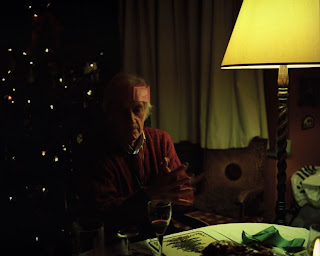My own approach was to work in a similar vein to my previous style: documentary of those close to, or known to me. But this time, whilst photographing them as they behave 'naturally', I would stop them and ask for a look. "Just a look to the camera, to me, and don't smile." I might also throw in the word "contemplate" or "serious", but nothing more, I didn't want to direct them further than that, and I was hoping that they would 'give' me something significant/symbolic to our relationship.
I suppose the thought was that in the first instance the photographs look at their privacy, their behaviour occurring without direct input from a photographer (although obviously altered by me lumbering about with a Mamiya & light meter). And then in the second instance, I really wanted to convey the connection happening through the camera, hence - intimacy. This can be just as quickly turned on its head if I argue that when these people are behaving more 'naturally' that is a better reflection of their true intimate character, which the viewer observes. And then when the interaction is forced, the viewer enters into a 'private' moment between photographer and subject, they are included rather than watching. And now we're back to the old familiar argument of definition - I'll leave it there.
Not that the results we're anything smashing, but I really enjoyed exploring this level of communication, and direction with my subjects, something I hope to grow.
There were a few other quotes/points of inspiration that came about from the lecture and discussion. Something that got me thinking was when we compared the different modes of titling of these intimate life works, i.e. Arbus would label and categorise her subjects whereas Goldin names and identifies them. The title of a photograph can have quite an impact, even alteration, to the viewing of it. Does "Gilles and Gotscho Embracing, Paris" invite the viewer in further, convey something of the photographer's tenderness? And does "Child with Toy Hand Grenade in Central Park, New York City" encourage the viewer to stay put and observe, judge, from a distance? In other words how dependant is the the title in the process of connecting the viewer? And what is the photographer hoping to achieve with their chosen method of titling? Which leads to:
"The more specific a photograph is, the more general it will be." Lisette Modell
I'm not sure that a photograph can be placed on a spectrum from specificity to generality (unless we're talking the basic clarity of representation of the subject) but I suppose in certain contexts, from certain perspectives, this will apply. I suppose in the sense of the intimacy privacy discourse, this relates to how universally recognisable a photographers individual opinions/bias/emotions are to the viewer, and the impact it therefore has.
"The point is that you can't get at the thing itself, the real nature of the sitter, by stripping away the surface. The surface is all you've got. All you can do is manipulate the surface - gesture, costume, expression - radically and correctly." Richard Avedon
"familiarity is complexity" Elinor CarucciSome definite 'thought feed' to be had here. More coming soon, the topic for next week is: 'looking from the inside'.








No comments:
Post a Comment